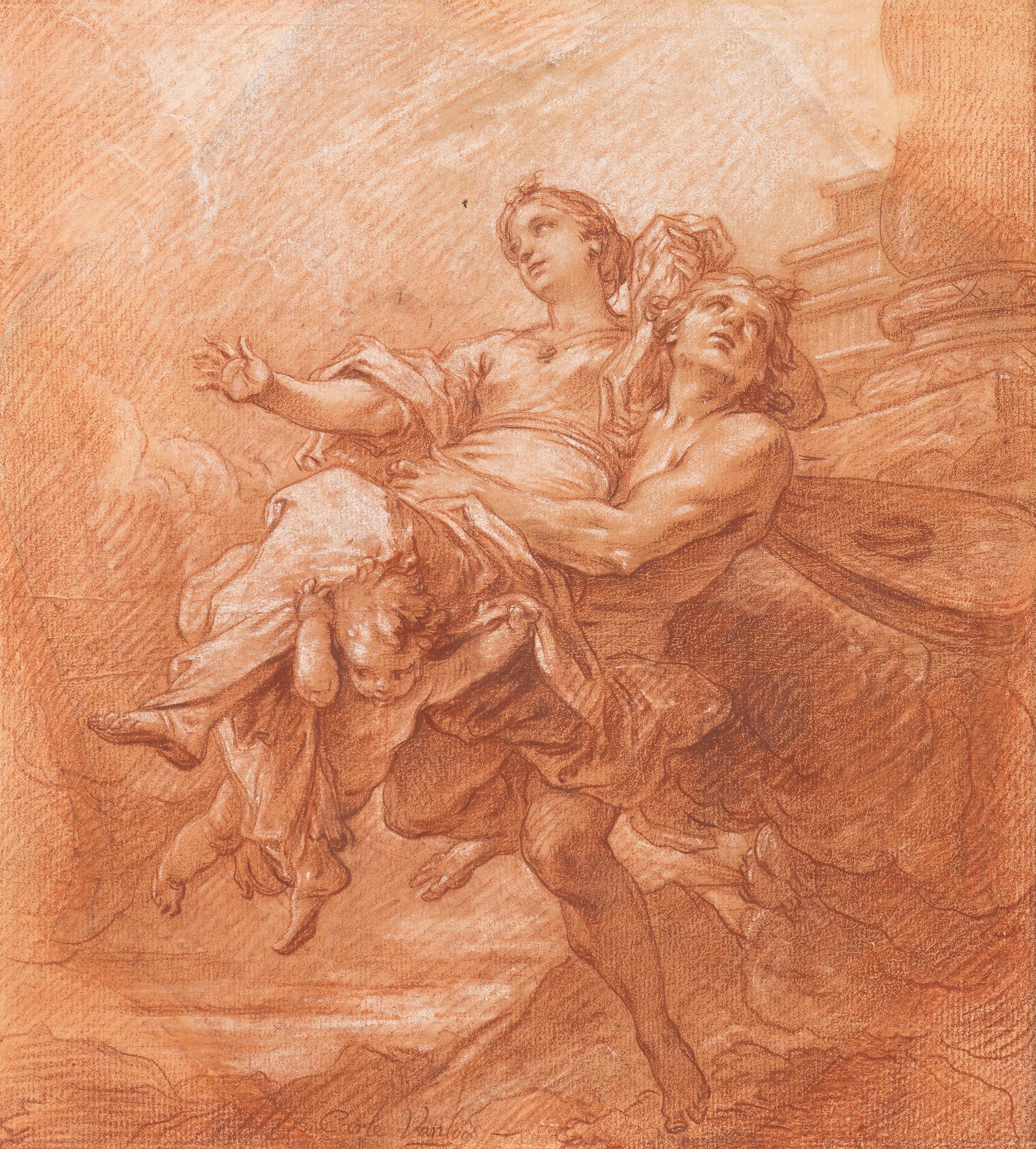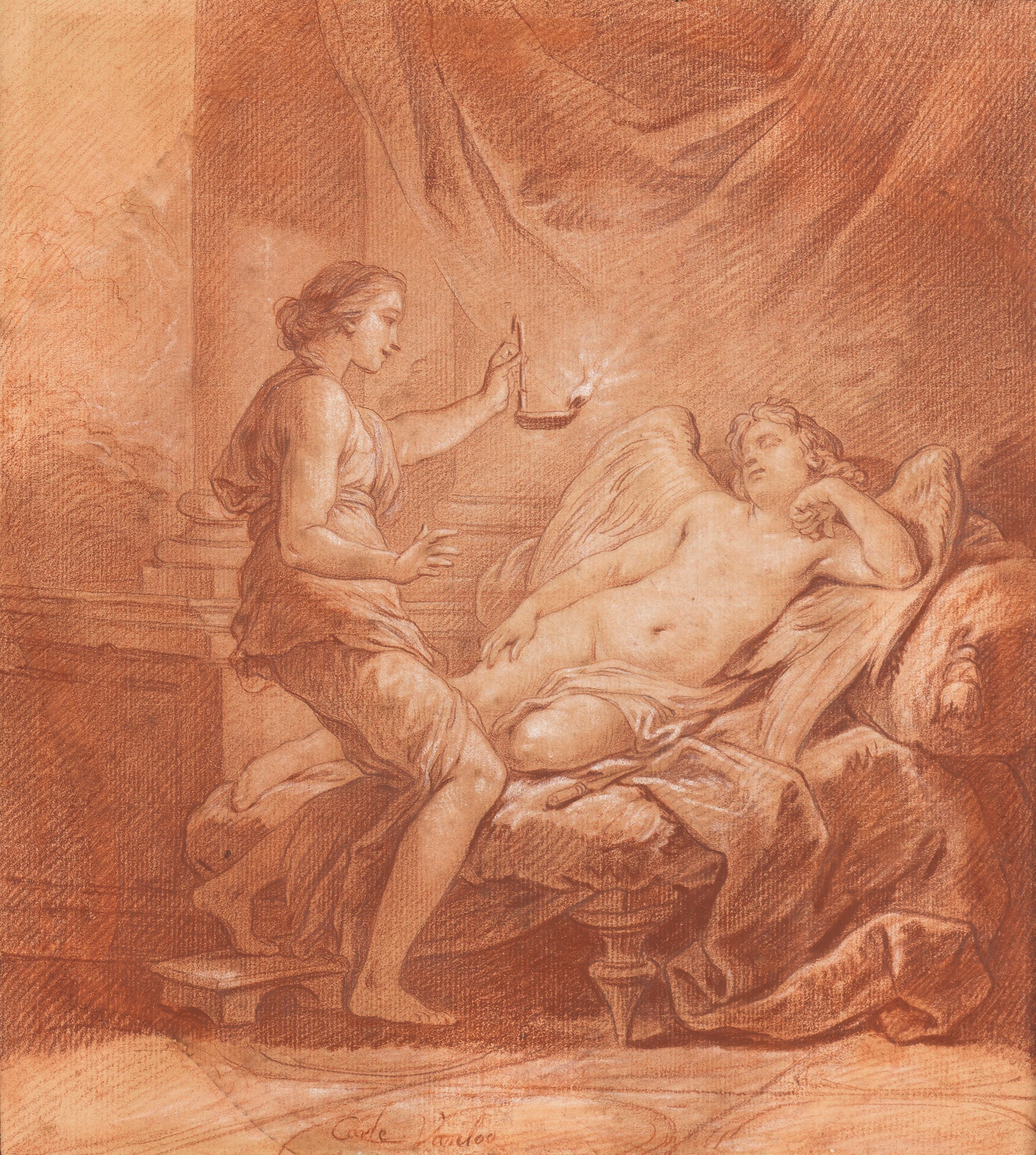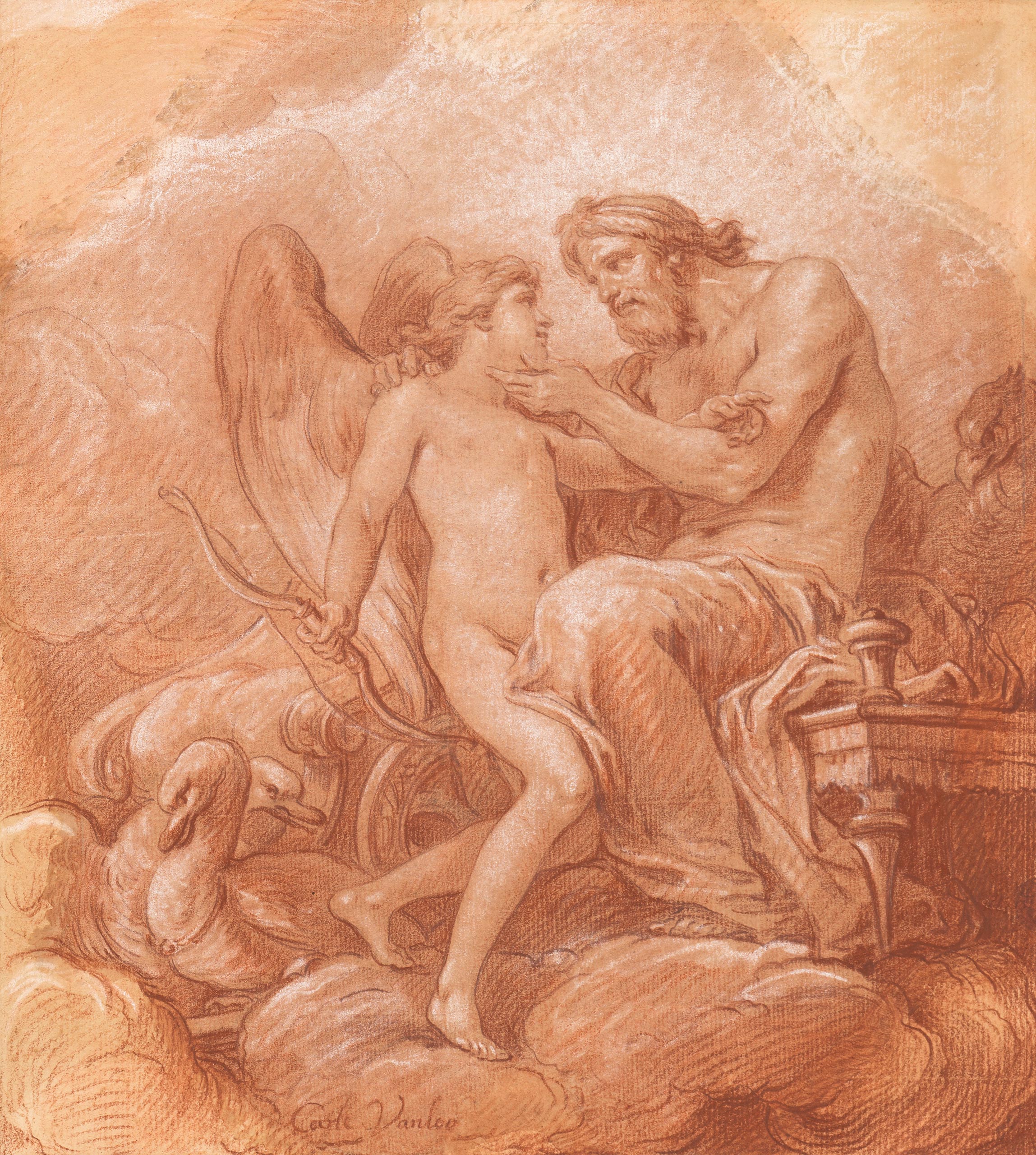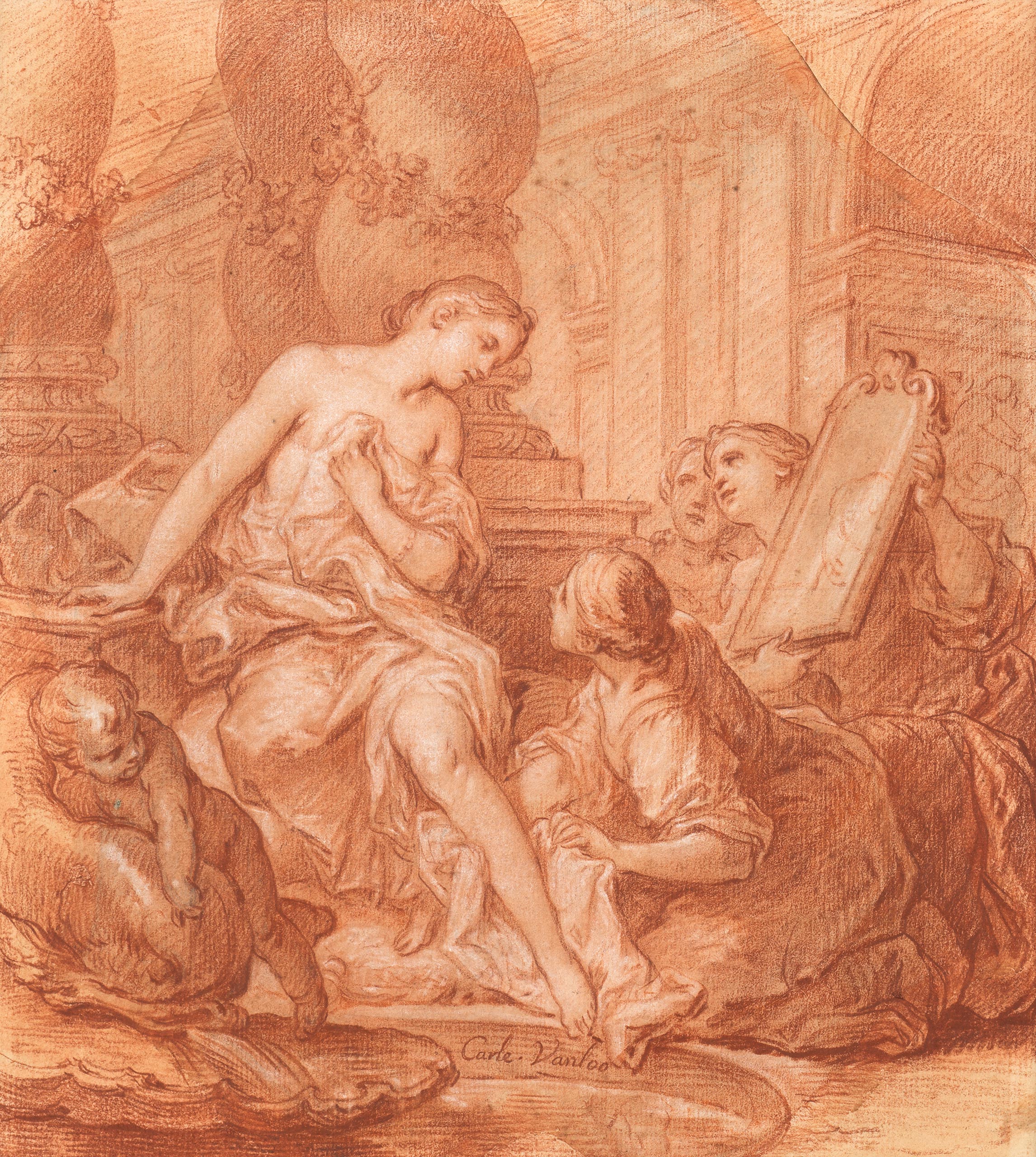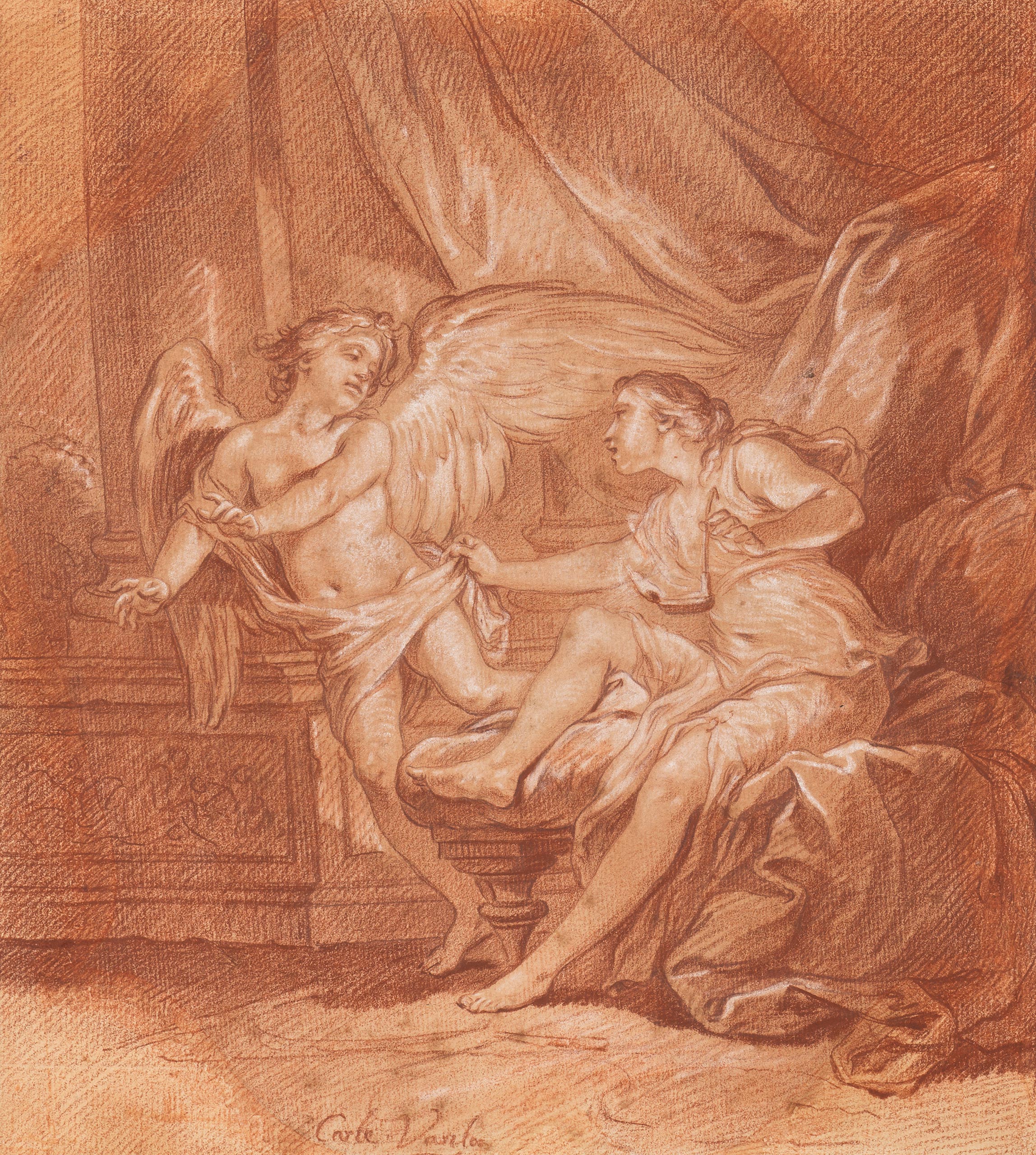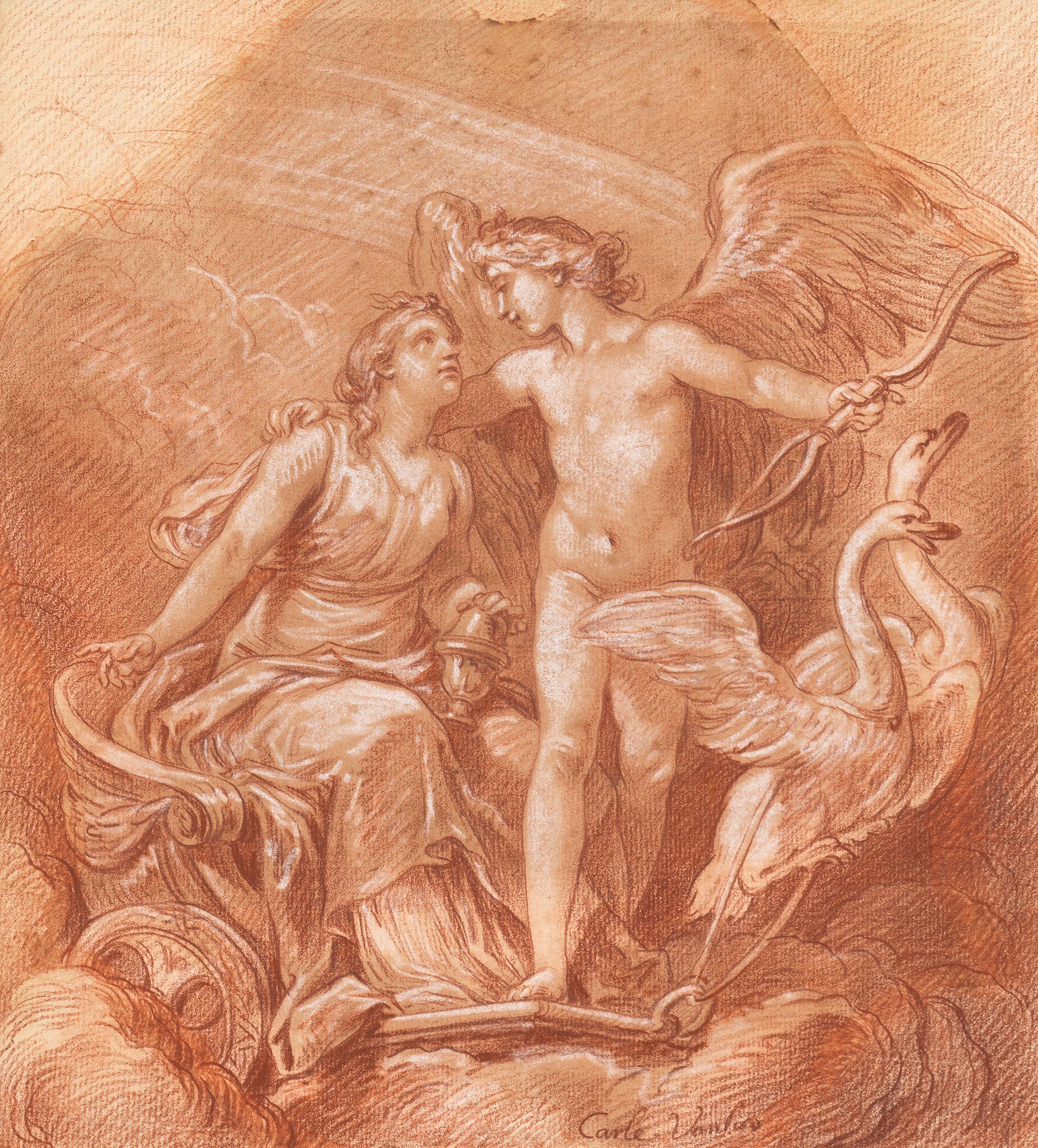
Van Loo
Carle
I. The Abduction of Psyche by Zephyrus
III. Psyche Discovering the Sleeping Cupid
V. Cupid and Jupiter
II. The Bath of Psyche
IV. Cupid Fleeing from Psyche
VI. Psyche and Cupid in a Chariot Drawn by Swans
I. The Abduction of Psyche by Zephyrus
II. The Bath of Psyche
III. Psyche Discovering the Sleeping Cupid
IV. Cupid Fleeing from Psyche
V. Cupid and Jupiter
VI. Psyche and Cupid in a Chariot Drawn by Swans
Red and white chalks, on paper, laid down onto its original mount.
The corners originally contoured and enlarged.
Framing lines with pen and black ink.
Signed lower center Carle Vanloo.
282 x 253 mm (11 1/8 x 9 15/16 in.)
Provenance
Lorenzo Somis collection (Van Loo’s brother in law) in Torino (cf. an estate inventory, 1775, lot n° 45, published by Baudi di Vesme in « I Vanloo in Piemonte », Archivio Storico dell’Arte, t. VI, 1893, p. 362).
Bibliography
Marie-Catherine Sahut, Carle Vanloo, Premier peintre du Roi (Nice, 1705 – Paris, 1765),
exh. cat, Nice, musée Chéret, 1977, n° 460a, p. 149 (as lost drawings).
Related Works
Two paintings from the Musée du Louvre, on deposit at the Musée de Versailles Psyche and Cupid in a chariot drawn by swans and Cupid fleeing from Psyche (MV 8283 and MV 8284)
Four red chalk counter-proofs are mentioned in the sale of the Marquis de Calvière, 5 May 1779, lot 524 : « Quatre Sujets de l’Histoire de Psiché, contre-épreuves, à la sanguine, par le même », bought by De Monval (unlocalized so far).
A drawing by Carle Van Loo : « Psyché regardant l’amour dormant sur un lit, beau dessin à la plume et lavé sur papier blanc, de forme contournée ». Its dimensions are approximatively 33,8 x 24,3 cm (« 10 pouces trois lignes de haut sur 9 pouces de large »). It appears in three sales: Vassal de Saint-Hubert, 29 March 1779, lot 107 ; Vassal de Saint-Hubert, 28 April 1783, lot 149 (in « drawings under glass ») ; Du Charteaux, 2 May 1791, lot 515. Each time, the buyer is the broker Remy. It has not been localized so far.
I. The Abduction of Psyche by Zephyrus
II. The Bath of Psyche
III. Psyche Discovering the Sleeping Cupid
IV. Cupid Fleeing from Psyche
V. Cupid and Jupiter
VI. Psyche and Cupid in a Chariot Drawn by Swans
I. The Abduction of Psyche by Zephyrus
II. The Bath of Psyche
III. Psyche Discovering the Sleeping Cupid
IV. Cupid Fleeing from Psyche
V. Cupid and Jupiter
VI. Psyche and Cupid in a Chariot Drawn by Swans
Red and white chalks, on paper, laid down onto its original mount.
The corners originally contoured and enlarged.
Framing lines with pen and black ink.
Signed lower center Carle Vanloo.
282 x 253 mm (11 1/8 x 9 15/16 in.)
Provenance
Lorenzo Somis collection (Van Loo’s brother in law) in Torino (cf. an estate inventory, 1775, lot n° 45, published by Baudi di Vesme in « I Vanloo in Piemonte », Archivio Storico dell’Arte, t. VI, 1893, p. 362).
Bibliography
Marie-Catherine Sahut, Carle Vanloo, Premier peintre du Roi (Nice, 1705 – Paris, 1765),
exh. cat, Nice, musée Chéret, 1977, n° 460a, p. 149 (as lost drawings).
Related Works
Two paintings from the Musée du Louvre, on deposit at the Musée de Versailles Psyche and Cupid in a chariot drawn by swans and Cupid fleeing from Psyche (MV 8283 and MV 8284)
Four red chalk counter-proofs are mentioned in the sale of the Marquis de Calvière, 5 May 1779, lot 524 : « Quatre Sujets de l’Histoire de Psiché, contre-épreuves, à la sanguine, par le même », bought by De Monval (unlocalized so far).
A drawing by Carle Van Loo : « Psyché regardant l’amour dormant sur un lit, beau dessin à la plume et lavé sur papier blanc, de forme contournée ». Its dimensions are approximatively 33,8 x 24,3 cm (« 10 pouces trois lignes de haut sur 9 pouces de large »). It appears in three sales: Vassal de Saint-Hubert, 29 March 1779, lot 107 ; Vassal de Saint-Hubert, 28 April 1783, lot 149 (in « drawings under glass ») ; Du Charteaux, 2 May 1791, lot 515. Each time, the buyer is the broker Remy. It has not been localized so far.
The reappearance of these six superb drawings, mentioned as early as 1775 in the inventory of Lorenzo Somis, Carle Van Loo’s brother-in-law, and since lost, constitutes a major addition to the catalogue of the artist’s graphic work. Of exceptional quality, all signed and kept in their original mounting, they form an ensemble of rare homogeneity and excellent condition. They constitute a narrative suite, the destination of which it is interesting to question, thus reviving research into Carle Van Loo’s works painted on the theme of Psyche for the first and second Dauphines at the court of King Louis XV.
These drawings were indeed created in the context of a royal commission received by Carle Van Loo in 1744 for at least two paintings depicting Psyche subjects for the apartment of the first Dauphine, Maria Theresa of Spain (1726-1746): Cupid Leaving Psyche (Fig.1)1 and Psyche and Cupid in a Chariot drawn by swans (Fig.2)2, still in the Chateau de Versailles today. Two of our drawings correspond very closely to these compositions (see Fig. 1 and 2).
Maria Theresa of Spain was married to Louis of France (1729-1765) on 18 December 1744 and the wedding was celebrated in Versailles on 23 February 1745. The young couple moved into an apartment in the Princes’ wing, the decoration of which is documented in several archive documents. The story of Psyche, which evokes the major themes of a love story in the world of the Olympian gods, was perfectly suited to the apartments of the young couple : encounters, pitfalls, jealousy, betrayal and reconciliation were daily concerns at the heart of a court ruled by a king with a penchant for gallantry. But bonded by their serious and pious temperament, Louis of France and Maria Teresa formed a very close couple, devoted to the Queen Marie Leczinska and opposed to Louis XV’s affairs and in particular to his favourite, Madame de Pompadour. The premature death of the Dauphine on 22 July 1746, following the birth on 19 July of her daughter Marie-Thérèse de France, left the Dauphin inconsolable for several months. The second Dauphine, Marie-Josèphe de Saxe, married the Dauphin on 9 February 1747 at the age of fifteen – a marriage strongly supported by Madame de Pompadour. A clever and tactful young woman, the princess gradually managed to win her afflicted husband’s affection and trust. In November 1747, the couple moved into another apartment located in the central wing, which in turn had undergone a lengthy renovation campaign, with reuse of furniture from the flats of the first Dauphine, including both Van Loo’s paintings of Psyche’s subjects3.
The history of the two paintings seems to be almost complete. Received by Ange Jacques Gabriel on 15 July 17444, they appear to have been placed in the apartments of the first Dauphine (in the Princes’ wing5), then moved to that of the second Dauphine (central wing), before returning to the Princes’ wing in the possession of the Count of Artois6. In 1784, Durameau reported them to the Surintendance warehouse. In Napoleon’s inventory, they are mentioned with smaller dimensions: perhaps they were cut to fit other frames. Then they are mentioned at Fontainebleau in the various inventories, before being brought back to Versailles in 1965 and placed in what used to be the grand cabinet of the Dauphine Marie-Josèphe de Saxe on the ground floor of the château. Although there are some inconsistencies in certain title descriptions, including those of Piganiol de la Force7 and the Napoleon inventory, the two paintings seem to be traceable almost exactly as they moved around Versailles and the other royal residences.
So how can we understand the link between our six drawings and the two paintings? Each of our drawings are signed; it is therefore certain that they were presented to the royal administration, if not to the King himself, for approbation. Three principal hypotheses can be put forward. The first is that Van Loo could have presented a choice of several compositions on the theme of Psyche, only two of which to be chosen to be painted as over-doors for the flat of the first Dauphine. The two painted compositions illustrate two culminating points of the story, the painful loss of love and the final reconciliation and happy ending – two themes perfectly suited to the life of a young princely couple who had to learn to live together and maintain good relations in the sometimes intriguing and treacherous environment of the court.
A second hypothesis is that Van Loo was commissioned to paint a complete series of scenes of Psyche for the first Dauphine, but was unable to do so because of her death and/or his bad health. This hypothesis is supported by the existence of an archive document from 1746 mentioning a down payment of 1600 livres8, i.e. an amount equivalent to that which he had been paid for the two first paintings in 1745, and by the existence of two other documents from 1747 mentioning two paintings representing Psyche and Cupid which were “not begun and which it would be useless to do”9. The documents also mention the necessity to pay for the artist’s preparatory work, in particular his drawings, of which our six works would then form part. Originally with a contoured shape, suggesting that the compositions were to be placed into a wood panel, the drawings had their corners rectified, probably by the artist himself or under his control, to form a beautiful decorative series to be inserted into mounts they still conserve today, framed and hanged on the walls. It is also possible that Van Loo was asked to complete the series begun for Maria Theresa of Spain for the apartments of the second Dauphine. In 1747, however, Van Loo fell ill and was unable to complete several of his projects, including a devotional piece commissioned for the second Dauphine. This could also explain why the entire series of six drawings was never completed in painting.
As to their provenance, the drawings are mentioned in in one of the after-death papers of Van Loo’s brother-in-law, Lorenzo Somis, who travelled all over Europe on his musical tours and often stopped off in Paris. It is well known that Van Loo regularly agreed to lend him works on condition that they would be returned to his heirs after his death. However, Lorenzo’s wills (11 December 1763 and 16 February 1766) establish a precise list of the works which will be given back to the painter’s wife, Cristina Somis, a list which does not include our drawings10. On the contrary, they appear in a later estate inventory of uncertain date but necessarily after his death (29 November 1775), an inventory which lists works of art meant to pass to Lorenzo’s heirs.11 Indeed, they do no appear in Cristina Somis’s after-death inventory. She did, however, own a drawing that could relate to Van Loo’s work on this theme, Psyche on the Island of Cythera12. The drawings then passed to Lorenzo Somis’s heirs, the sons of his brother Giovanni Battista: Saverio, Ignazio and Felice Somis, and it is in the archives concerning their estates that the drawings must be sought and perhaps found – if they are mentioned at all.
Four counter-proofs of drawings depicting subjects of Psyche are mentioned in the sale of the collection of the Marquis de Calvière. They cannot relate to our drawings, in which the red chalk is so fresh and vigorous. However, it does indicate that the preparatory work carried out by the artist in the context of this commission, for which the archive documents also mention the need for payment, was very important in terms of both quantity and quality.
Carle Van Loo’s treatment of the story of Psyche was naturally inspired by Apuleius’s account in The Golden Ass, but also by Jean de la Fontaine’s version. These two authors tell the story of how Psyche’s perfect beauty leads her to face a series of setbacks before a happy ending: Aphrodite, stung by being neglected in favor of this young, beautiful mortal, demands vengeance from her son, Cupid or Love, “that winged rascal who respects neither morals nor police, who sneaks into people’s homes like a thief in the night, with his features and his torch, looking everywhere for households to disturb, evil to do, and never thinking of the good”13. But this was without taking into account the charm of the young woman with whom the teasing god himself fell madly in love. On his orders, Zephyr kidnaps her and carries her in an enchanted mansion where she is served with care. Love visits her every night, asking her never to seek him out or learn his identity. She obeys, until in her grief she asks permission to send for her sisters. Mad with jealousy at such luxury, Psyche’s sisters urge her to break her oath and look at her lover at night, claiming that he must be a horrible monster playing with her, the better to devour her. One night, as Psyche gives in to curiosity and discovers, in wonder, the beauty of her sleeping lover, a drop from her oil lamp falls on him and awakens him; betrayed Love immediately flies away. Psyche clings to his leg to hold him, but he drops her off in the countryside and disappears. In despair, Psyche wanders off and seeks protection from Ceres and Juno, but Venus, who has meanwhile learned of her son’s romance, sends for her in revenge. The Goddess of Beauty subjects Psyche to three tests, which she passes with the help of the elements. A fourth ordeal leaves her asleep in the Underworld until Mercury rescues her on the orders of Jupiter, who has given in to Love’s request and accepted their marriage. In his version of the story, narrated in a more prosaic, sometimes burlesque tone, Jean de la Fontaine enriches the ancient tale with several details and episodes. Some of them, such as the nymphs surrounding Psyche at her bath, who are mentioned in La Fontaine’s version only, inspired Carle Van Loo.
To address the story of Psyche and nourish his inspiration, Van Loo could turn to the great earlier artistic references : for example, the series painted by Raphael and his pupils in the Villa Farnesina, which probably inspired Van Loo to paint the scene of Jupiter embracing Love (executed by Raphael’s pupil, Giulio Romano; Fig. 3), or the series executed by Giulio Romano in Palazzo Te in Mantua. Interestingly, Romano’s treatment of the subject of Psyche and Love in a chariot drawn by swans (Fig. 4) in a box of the vault is close to Van Loo’s but the French artist gave it a lighter, more tender atmosphere. Neither could Van Loo fail to be familiar with the celebrated and lavish set of tapestries bought by Francis I of France around 1540, the conception of which was then thought to be by Raphael but is nowadays given back to Pieter Coecke Van Aelst. Destroyed in 1797 in order to reuse the golden and silver threads with which it had been weaved, the series of 26 tapestries were extremely admired and copies were made by the French manufactures during the 17th centuries. Although Van Loo’s compositions differs from the tapestries, the painter surely had their prestige in mind and tried to emulate them while he was working over his own royal commission on the same subject. Lastly, an unpublished early painting by Carle Van Loo of Love fleeing Psyche (Fig. 5) shows that he had already treated the subject at some point between his two stays in Italy (1712-1720 and 1727- 1733); his style was then totally influenced by that of Benedetto Lutti. Van Loo had met him in Rome when he was the teacher of his brother Jean Baptiste. The existence of this work shows that Van Loo, having previously given some thought to the subject of Psyche, was in a position to produce a most attractive series.
Finally, these drawings should be situated in the wider context of Van Loo’s graphic work, in which he made use of all kind of techniques, favouring sanguine or pierre noire alone for figure studies, and enjoying mixing different mediums to give his compositional drawings a highly pictorial quality. As it happens, drawings by Van Loo from the 1740s are rare; there are fewer than fifteen in Marie-Catherine Sahut’s catalogue, even including the seven drawings acquired by Gustave Tessin between 1739 and 1741 and nowadays in the Stockholm Nationalmuseum. Our six drawings are therefore an important addition to our understanding of the artist’s style during this decade. The physical type of the female figures in our drawings is very similar to that of the allegory of Painting in one of the Stockholm drawings (Inv. 2910/1863), and the draughtsmanship and style are completely comparable to a drawing in the Musée Paul- Arbaud in Aix-en-Provence, Saint Charles Giving Communion to the Plague Victims, a preparatory work for the 1743 painting on the same subject (Paris, Notre-Dame). It shows the same way of combining a vigorous red chalk with significant white heightening, of drawing the hands, the musculatures, the faces and above all it shows the same abundance of materials throughout the sheet; the one in Aix-en-Provence additionally bears black chalk which makes it even more contrasted. In our series, Van Loo excelled at combining grace and vigour, to produce visually strong, immediately perceptible and extraordinarily attractive project drawings.
Their graphic quality, their excellent condition and the great elegance of their composition make these drawings works of the utmost importance in the artist’s corpus, a major addition to the catalogue of his works and an essential testimony to his activity at the court of Versailles. Van Loo created personal and original compositions while at the same time knowing how to refer to great earlier models, a quality of erudition that was absolutely essential among the painters of the King and the Royal Academy. His tender, playful and luminous illustration of the story of Psyche is entirely representative of the aesthetic of the private apartments of Louis XV’s family at Versailles, that of a joyful rococo tempered by standards of balance and decency.
- Musée national des châteaux de Versailles et de Trianon, MV 8283, INV6274, MR2564.
- Musée national des châteaux de Versailles et de Trianon, MV 8284, INV6273, MR2565.
- Xavier Salmon, « Une femme sous influence Marie-Josèphe de Saxe et les Arts à Versailles » in exh. cat. Splendeurs de la cour de Saxe, Paris, RMN, 2006 (p. 108-119), p. 111.
- Archives Nationales, O1 1813, fol 154 vo, published by Christian Baulez, « Le grand cabinet et la chambre de la Dauphine », La Revue du Louvre et des Musées de France, 1976, n° 3, p. 184-185.
- Jean-Aimar Piganiol de la Force, Nouvelle description des châteaux et parcs de Versailles et de Marly : contenant une explication historique de toutes les peintures, tableaux, statues, vases & ornemens qui s’y voyent : leurs dimen- sions & les noms des peintres, des sculpteurs & des graveurs qui les ont faits : enrichie deplusieurs figrues en taille-douce : dédiée à SAS monseigneur le comte de Toulouse, Paris, 1751, tome I, p. 328 ; Xavier Salmon, op.cit., 2006, p. 111.
- Letter from Jeaurat to Dandré-Bardon, 1765 (BNF Archives et Manuscrits, Français 13081, 268 et 269) ; Dezallier d’Argenville, Voyage pittoresque, 1768, p. 95.
- Piganiol de la Force, cit., p. 328.
- Paris, Archives Nationales, O1 2245, f° 25 v°.
- Paris, Archives Nationales O1 1932 published in Engerand, Inventaire des tableaux commandés et achetés par la direction des bâtiments du roi, Paris, 1900, p. 474 and Archives Nationales, O1 1922B.
- Baudi di Vesme, « I Vanloo in Piemonte », Archivio Storico dell’Arte, VI, 1893, p. 360.
- cf. his estate inventory, after 1775, lot n° 45, published by Baudi di Vesme, idem, p. 362.
- Archives Nationales, Minutier Central, LVI 312, 21 avril 1785.
- Apuleius, IV, 30,4.

